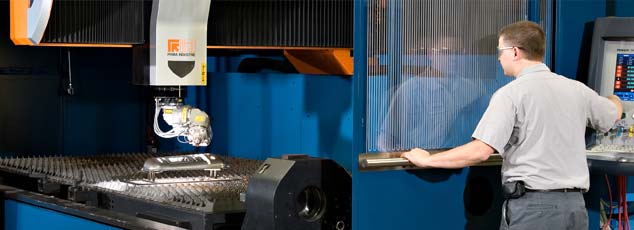By providing 3D-laser welding capabilities in the sheet metal welding industry, Estes Design and Manufacturing is able to weld products that require minimal post-weld grinding or finishing, resulting in labor and material cost savings for its clients.
3D laser welding uses concentrated light energy to fuse metal parts into a very precise joint that is strong and highly aesthetic. Energy from the focused and directed beam is absorbed at the precise weld site and the surface temperature rises. In mere milliseconds, the metal begins to melt. Because the energy is concentrated on a tiny area, the heat affected zone (HAZ) surrounding the weld site is much smaller than in traditional welding, resulting in less distortion or damage to the workpiece.
Lasers operate in two modes: pulsed and continuous wavelength (CW). Pulsed lasers are often used for spot welding, because the adjustable spot size allows for strong, deep, precise welds. Pulsed lasers are used for electronics and heat-sensitive parts. In CW mode, the laser stays on until stopped. The weld is almost instantaneous with the beam on command. Estes welds at a rate of 100 to 160 IPM in CW mode.
CW lasers perform two types of welding: conduction and keyhole. Conduction welding results in a wide, shallow seam that is smooth and requires little or no finishing. This type of welding is often the choice for thin materials like foil, wire, narrow tubes and provides the smooth appearance that is desired for highly cosmetic welds. Keyhole welding creates a narrow, deep weld by initially vaporizing, and then redepositing metal at the weld point as the beam advances. Both are autogenous processes, meaning filler material is not used to help create the weld profile. Keyhole welding increases part strength, and works with thicker sheet metals and is generally a faster process welding at speeds up to 240 ipm.
A residual benefit, Laser welding makes it possible to redesign parts for more efficient production.
Part fit-up is critical; gap tolerance requirements are low as there is no filler used. With fit-up in mind, you can change the number and type of joints needed. Flanges, for example, can be made narrower or even replaced with butt joints. Further, because a laser welding robot only needs access to one side of a piece, welding in tight areas is possible.
Laser welding means savings. Time savings is the result of fast-moving robotic welders, computers that calculate spot size and minimal post-weld processing. Estes is able to cut welding time down by almost 85% because of these capabilities. To break it down, laser welding results in more active welding time, shorter cycle time and higher throughput.
In a project in which Estes had to perform a 10” weld on 16-gauge cold rolled steel, the company was able to take the total cost of $5.84, with traditional TIG welding, to $0.96 with 3D laser welding. Estes has used this cost-saving technique to benefit several clients in industries including: medical, appliance and office furniture. Laser welding creates savings in material costs and reduces weight, as narrow flanges mean less material and less weight, and single-side access and redesigned joints mean fewer welds overall. It also helps realize a cost reduction in post-weld cleanup materials.
Laser welding is fast and flexible. How will you put it to work for your sheet metal applications? Contact the Estes team at 317-899-2203 or sales@estesdm.com to discuss value engineering, part design, and potential savings.








